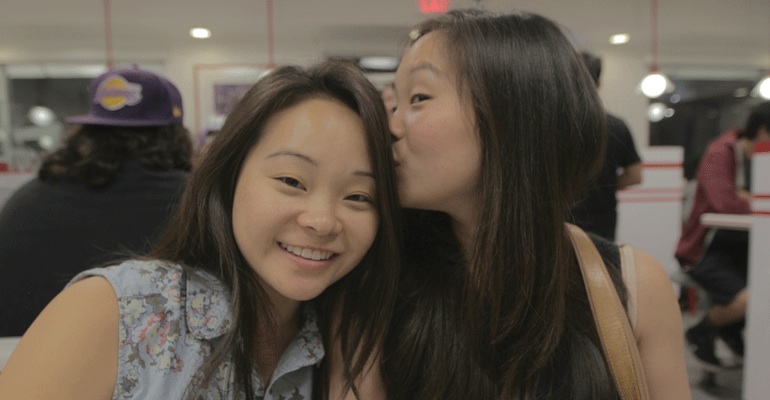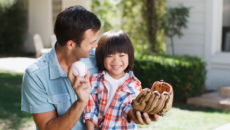Painting each other’s nails, sleeping in the same bed, sometimes trying deliberately to annoy the other — these are the admittedly “cheesy” things that sisters Anaïs and Samantha like to do together, though they are grown-ups. Each turned 27 in November, but prior to last year, they never had the chance to engage in these mundane sibling activities that go on to become treasured childhood memories. They are reunited identical twins — two sisters born in Korea, but separated at birth. Adopted as babies into different families, Anaïs Bordier, raised in Neuilly-sur-Seine, France, and Samantha Futerman, raised in Verona, New Jersey, never knew about the existence of the other, until a YouTube video and Facebook message led to their reunion 25 years later.
It’s a premise that prompts an innate jaw-dropping response, not to mention comparisons to the film The Parent Trap, in which Lindsay Lohan plays separated twin sisters, one of whom grows up in America and the other in England. The sisters have shared their stranger-than-fiction story in a full-length documentary, Twinsters, and a book, Separated @ Birth: A True Love Story of Twin Sisters Reunited, released by G.P. Putnam’s Sons.
Indeed, theirs is a love story, and the book chronicles many of the key moments of that blossoming sisterhood, from their first Facebook contact and Skype conversation, to reuniting in London and traveling together to Korea, their birthplace. Anaïs and Samantha, who goes by Sam, pen alternating chapters, allowing each sister to have her own distinct voice — Sam’s more straightforward, often humorous, and Anaïs’, with more of a poetry to it — as she recounts and reflects upon many of the same events. They also distill their very separate experiences as Korean adoptees growing up with their respective white families in France and America.
Different from Sam, who has two older brothers (the biological children of the Futermans), Anaïs grew up an only child and often fantasized about having a sibling; she even dreamed up an imaginary friend named Anne. So, imagine her surprise when a college pal tells her that he came across a YouTube video featuring a young American actress who looked just like Anaïs.
After discovering the actress’s name, Anaïs learns as much as she can about this familiar stranger, including her birthdate — November 19, 1987, the same as Anaïs’s — and even finds a video where Sam talks about being adopted. Anaïs then works up the courage to send a Facebook message that starts, “Hey, My name is Anaïs, I am French and live in London. My friend was watching one of your videos on YouTube, and he saw you and thought that we looked really similar … like VERY REALLY SIMILAR … So I don’t want to be too Lindsay Lohan, well … but … how to put it … where were you born?”
Across the globe, Sam is primping herself for the big movie premiere for the film 21 & Over, in which she costars, when she receives an alert to check out a Facebook message. Looking at Facebook pictures of Anaïs, a shocked Sam says it’s like looking in a mirror.
They begin exchanging birth records and childhood pictures, which reveal few clues other than their common birthdate, birthplace and strikingly similar appearance. Their birth family histories, including the descriptions and circumstances of their biological mother, are actually quite different, but Sam notes that it’s not uncommon for such details in adoption papers to be unreliable. The two then arrange a Skype call.
Just as Anaïs, who speaks English with a British-tinged French accent, starts to apologize for her poor Internet connection, Sam blurts, “Oh my God, you’re European!”
And then she erupts into laughter. Anaïs starts laughing. It’s the same laugh. They speak for three hours, only stopping because they have to go to the bathroom. They cover their childhoods, their studies, boyfriends, medical information (nerve disorders around the same age), their small hands.
“I’d gone into the call exhausted from the long days I had been spending on my designs, but now, I was suddenly energized,” Anaïs recounts in the book. “I did not want to go to bed for fear Samantha might disappear, or that it would turn out that this was a dream and when I woke up, she’d be gone.”
Sam says, over the following nights, she couldn’t wait to talk to Anaïs again. “I was becoming an Anaïs Bordier addict — I couldn’t get enough of her, and I was getting the feeling that she couldn’t get enough of me, either,” she writes. “I guess you could say we were becoming self-obsessed.”
In the months that follow, they would learn about their uncanny similarities, including a disdain for cooked carrots in soup, their partiality to curse words and animal costumes for Halloween, how they cope with stress by napping, and their common artistic persuasion, with Anaïs studying fashion design and Sam pursuing acting.
Though many would like to believe separated twins “sense each other,” or feel like their other-half is missing, Sam and Anaïs say they never felt that. And it was perhaps a sense of disbelief that caused Anaïs to poke Sam in the head when they first meet in London — making sure this 4-foot-10, freckled American look-alike was real.
While they are in London, accompanied by both sets of their adoptive parents, DNA tests would confirm Anaïs and Sam are identical twins. A series of other tests conducted by a twins expert at the California State University, Fullerton, would also reveal the sisters had similar IQs (Sam’s was slightly higher, though Anaïs thinks this is because it was an American-made test; she requests a “rematch”) and dispositions, with nearly identical scores for “openness, conscientiousness and agreeableness” — consistent with findings about twins who grow up apart. “Dr. [Nancy] Segal had said reared-apart twins were more similar than those raised together because they weren’t fighting to be different,” Sam writes. “They were letting nature take its course.”
But they have their differences, too. Anaïs is, in fact, .75 inches taller. Sam’s memory is stronger than Anaïs’, which could be due to the fact that, as an actress who has also worked as a waitress, she has to do a great deal of memorizing. Meanwhile, Anaïs outperformed Sam on visual-spatial tests, probably because of her design background.
The sisters note that such results indicate how their differing cultural environments and upbringing may have played a role in their personalities. Sam writes in the book that she got to grow up with two older brothers, which helped her grow thick skin, whereas Anaïs, being an only child, seemed to be more sensitive to negative comments.
In a particularly touching moment in the book, the twins make a striking observation about how their personalities seem to reflect those of their respective foster mothers, whom they met last summer during a trip to Korea for an adoptee conference. Sam’s “touchy-feely” foster mother gives big smiles and big hugs, not unlike Sam’s outgoing personality, whereas, Anaïs’ foster mother is kind and happy, but more reserved, taking time to warm up to people, similar to Anaïs.
For Sam, this was her second time meeting her foster mother, but for Anaïs, it was her first, and the encounter was powerful for a young woman who, as a child, sometimes agonized over being abandoned by her birth mother. She realized someone loved and cared for her, even during her earliest days on earth.
“I was able to see how much of a huge influence on my life and on the person I became she was,” says Anaïs about her foster mother. “It was one of the biggest surprises of the whole Korea trip — how everything counts in your life, even when you’re a baby and you don’t necessarily remember it.”
At one point in Separated @ Birth, Sam admits it’s difficult to describe the strong, almost natural bond she and Anaïs feel, even though they missed out on coloring in a 25-year history together.
“In life, there exists sympathy and empathy. I have both of these with Anaïs,” she writes. “But what I have with her is beyond that. I have literally felt in my body what she is feeling. I know exactly where in her throat she gets choked up when she gets upset and the blood rushes to her face. I know how hot it actually feels. It’s not telekinesis we have, but the ability to recognize and fully experience what the other is going through.”
The book not only details their bond, but also the relationships their respective families have nurtured. It’s almost like their entire families have adopted each other, the twins say. Last Thanksgiving, they had a joint celebration at Sam’s parents’ home in New Jersey, and they plan to meet again in New York for their daughters’ book launch. “They find comfort in knowing each other,” Sam says.
Sam admits she didn’t fully appreciate the impact their story could have, until after they launched their Kickstarter campaign for Twinsters, which she plans to submit to festivals next year. “At first, it’s just, like, our story is crazy, of course, we have to share this! Then, through Kickstarter, we got a lot of press and a lot of adoptees began to reach out to us,” she describes.
“Some said, ‘Now I’ve decided to go and search for my birth family, and I never thought I’d do that.’ It became really, really moving. We started to realize that this story was bigger than ourselves, and can actually be something that other adoptees can look up to … because Anaïs and I didn’t really have those people to look up to when we were kids — to have a figure to say, ‘You know, I went through it, and it’s OK, and you’re strong enough, and you’ll be able to do it, too, no matter what the outcome is.’”
It’s still unclear how Anaïs and Sam came to be separated after birth — the agencies that handled their adoptions told their parents they were single births — and they realize they may never know the truth, or meet their biological mother or father. They wrote a letter together to their birth mom that will be kept on file at Sam’s adoption agency in Korea, should she ever look for them. If she ever reads the letter, she will know that her daughters found each other from opposite sides of the world and that they are happily reunited.
And that happiness has been transformative.
“You know what’s funny? A lot of adoptees yearn to find someone who looks like them,” says Sam. “That’s how I felt. I wanted to find someone who looked like me — freckles, lighter shade of brown hair. It’s such a comfort, finding people that you recognize and feel comfortable around. You realize it’s all going to be OK.”
Anaïs says, since meeting Sam, she feels more confident. “I’m not as scared,” she says. “I can accept myself a lot easier. I feel a lot more comfortable around everyone. I’m not worrying that much as before. You feel stronger when you know there are two of you.”
Today, Anaïs is working in Paris as a leather goods designer for Gerard Darel, and Sam continues to work as an actress in L.A., as well as on post-production of Twinsters. Sam has also founded Kindred: The Foundation for Adoption, an initiative to help with services like travel, translation, and therapy for international and domestic adoptees and their families. Though they live on different continents, the twins say they are in constant contact, often texting each other throughout their waking hours.
If the sisters have learned anything from this experience, it’s that anything is possible, they say.
“Sometimes you might think that you know everything that’s going to happen,” says Anaïs. “But you have no idea what the universe has set for you. You should always live day by day, and let yourself be surprised because a lot of good things can happen to you. That’s what’s beautiful in life.”
“Just that simple act of being open,” says Sam.
“Oh, my god, we’re twins!” Anaïs squeals.
“We’re twins!” Sam exclaims back.
A longer version of this article was originally published in KoreAm Journal. It is reprinted here with permission.
This story is part of a two-part series on reunited identical twins. Read Part 2 HERE.


